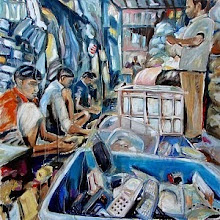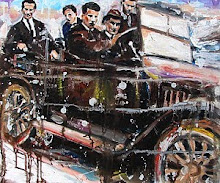In the past, the technologisation of work produced frantic and panicked reactions in the Luddite conflicts of the early 19th century. Since then we have been lulled into complacency by visions of wealth and prosperity and more leisure time.
The current crop of robotic developments and inventions have produced a huge ‘aaw’ factor as dancing, walking and talking, ‘Livin’ Robots’ have entertained people all over the world. However, this is merely a transition period of finding general acceptance by an unsuspecting public who are unaware of how close they are getting to a labour crisis of disastrous proportions.
The recent history of machines and robotic devices shows us that the world of technological advancement steams ahead with or without the consent of the workers whose jobs are ultimately displaced forever. How did we get from Luddite frame breaking to ‘Loving the Alien’?
There is what could be described as three levels of the technologisation of work,
(1) Basic Machines (Simple and Engine),
(2) Complex Machines (Electrical, Electronic and Computing), and
(3) Sophisticated Machines (Anthropomorphic
Robots).
In each case technologisation has brought benefits as well as
disaster. However, we are reaching a point where further
technologisation can only exacerbate the global problems of mass
unemployment, climate chaos, depletion of the world’s resources and
exceed the planet’s capacity for recovery.(1) Basic Machines (Simple and Engine)
“Surely my lord
however we may rejoice in any improvement in the arts which may be
beneficial to mankind, we must not allow mankind to be sacrificed to
improvements in mechanism. The maintenance and well-doing of the
industrious poor is an object of greater consequence to the community
than the enrichment of a few monopolists by any improvement in the
implements of trade, which deprives the workman of his bread, and
renders the labourer ‘unworthy of his hire.’” Lord Byron’s speech to the House of Lords February 27, 1812, at the height of Luddite activities in Yorkshire, England. [1]
Warring with Rude Nature
The introduction of machines during the Industrial Revolution became the focus of anger of the English textile artisans in the early 19th Century. The new stocking frames, spinning frames and power looms enabled the factory owners to replace artisans with cheaper low-wage labourers. This resulted in the unemployed textile artisans coming together and attacking the factory machinery and burning down mills. Known as Luddites, these men and their supporters battled with the industrialists and the British Army from 1811 to 1817. The government eventually quashed the movement with show trials resulting in many penal transportations and executions. [2]
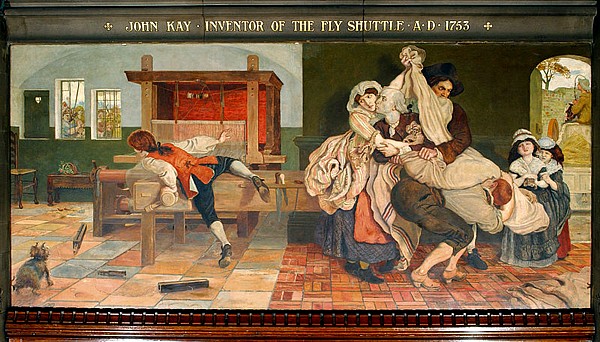
John Kay inventor of the Fly Shuttle, by Ford Madox Brown.
(depicting the inventor John Kay fleeing a mob intent on destroying his mechanical loom.)
(depicting the inventor John Kay fleeing a mob intent on destroying his mechanical loom.)
The significance of the introduction of machinery and the long term effects of the Luddite movement was not lost on Friedrich Engels, who wrote in 1845:
“The service which machinery has rendered the workers is simply this: that it has brought home to their minds the necessity of a social reform by means of which machinery shall no longer work against but for them. […] Every new advance brings with it loss of employment, want, and suffering, and in a country like England where, without that, there is usually a ‘surplus population’, to be discharged from work is the worst that can befall the operative.” [3]The struggle against the machines soon became a struggle for control of the machines.
(2) Complex Machines (Electrical, Electronic and Computing)
“When was the last time a real
receptionist texted you about an important call? Or worked 24/7 (there’s
labor laws against that)? A virtual receptionist works for peanuts and
doesn’t demand benefits.” [4]
The computers are coming
For the next one hundred years the existence of factories became accepted and trade unions took on the challenge of resistance to the factory owners. However, the spread of the machines in the workplace was really only beginning. In 1951, the first commercial business computer was developed in the United Kingdom by the J. Lyons and Co. catering organization. It was known as the ‘Lyons Electronic Office’ – or LEO for short. The LEO computer was further developed and then widely used during the 1960s and early 1970s. [5]
During a visit to USA Lyons’ managers met Herman Goldstine, one of the original developers of ENIAC (Electronic Numerical Integrator And Computer), the first general-purpose electronic computer (although it had no stored program). [6] In 1953 IBM (International Business Machines) introduced the 701 to the public, their first electric computer and first mass produced computer. [7]
Avoiding the type of knee-jerk rejection of new technology by the early Luddites, a softly-softly approach to mass acceptance of computers was created through information films such as “Electronic Computers Improve Management Control” (UCLA 1957) lauding their efficiency and advantages, and cinematically by films such as Desk Set (1957) summarised as:
“Richard
Sumner (Spencer Tracy), the inventor of EMERAC (an allusion to the
early computers UNIVAC and ENIAC) and an efficiency expert, is brought
in to see how the library functions, to figure out how to ease the
transition. […] When they find out the computers are coming, the
employees jump to the conclusion the machines are going to replace them,
whereas they are merely intended to help ease the research.” [8]
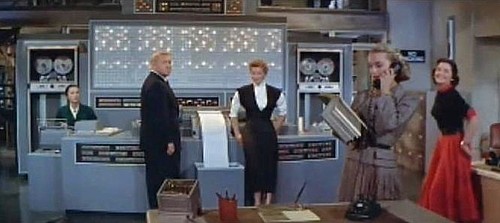
Desk Set (1957)
When the ‘silly computer’ fires everyone in the building by mistake, Sumner has to explain that EMERAC‘was never intended to take over’ to ease the anxiety of workers. The support of IBM for the film is acknowledged in the opening credits: “The filmmakers gratefully acknowledge the cooperation and assistance of the International Business Machines Corporation.” [9] The optimistic message of Desk Set had changed by the late 1960s with the Jerome Epstein film The Adding Machine (1969) about ‘an accountant whose job is about to be taken over by a computer [and who] starts to re-examine his life and his priorities.’ [10]
By the 1980s, according to Alan Nasser, the effects of the introduction of computers were such that:
“An office in the 1980s employing 40 people working without computers may require, in the early 1990s, only 4 workers using 4 computers. The productivity – output per unit of labor input – of the office can be further enhanced not by adding skilled workers nor by replacing less productive workers with more productive computers, but by replacing less powerful computers and software with more powerful ones. In the initial case, actual workers were replaced by computers. In the latter case potential workers were kept out of the workplace by better computers.”
Over the last few decades we have seen the introduction of technology changing working class jobs such as the use of hand scanners and self-service check-out machines in supermarkets, stamp machines in post offices, electronic toll collection, automated attendants in telephony, virtual receptionists, ticket machines in car parks and train stations and swiping machines and integrated security systems affecting security guards.
More and more middle class jobs are under threatwith the Automated Teller Machine (ATM) in banks, the use of the internet for shopping, translation, and teaching.
In the same period of time the technologisation of factories has seen the introduction of factory robots working on fully automated production lines and then packaging and palletizing, automated guided vehicles (AGVs) transporting goods around warehouses, automated fruit harvesting machines and telerobots.
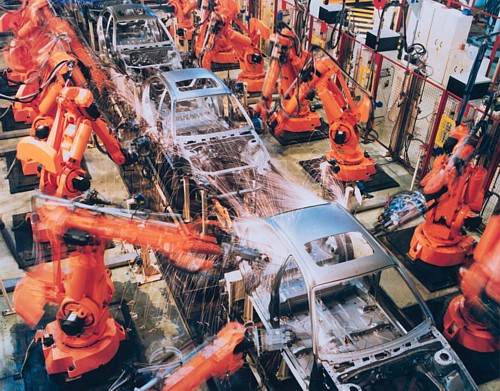
In fact, we are mesmerized by the potential use of robots. In an article by Aaron Saenz he notes the “awe-inspiring, perhaps even frightening” aspects of modern manufacturing:
“The factories of
today have some human workers, but huge portions of assembly lines are
100% mechanized. The US Bureau of Labor Statistics expects automotive
jobs to decline 18% by 2018 despite expected increases in production.
Robots eliminate the need for more workers. Before you lament the loss
of jobs, take a moment and watch how robots earn their role every day in
the workplace. Incredible!”
Our fascination with robots is overcoming our
cautious nature as we are once again presented with images of the new
‘silly machines’.(3) Sophisticated Machines (Anthropomorphic Robots)
“Imagine a world where the robots did all
the work. They tend the crops, sew the clothes, cook the food, drive
the trucks, and work on all the assembly lines in all the world’s
factories. In this world, everything would be a lot cheaper because
labor costs would drop to zero. In fact, there’d be a startling
abundance of stuff. And people would be freed up to do things other than
work. We could use our time to explore, create, perform, craft, mingle,
and so on because we wouldn’t have to work to produce the necessities
or luxuries of life; the robots would be taking care of that.” [11]
Fascinating Robots
The titles of the videos about the latest robots (Dancing Robots, World’s Top3 Humanoid Robots, Most Human Like Robot Ever) reveal one strategy of acceptance: narcissism or self-admiration.
The more robots look, act and behave like us, the more we forget that robots are separate and are not extensions of ourselves. While we ‘lose ourselves’ in the robot, we also lose sight of the potential dangers inherent in re-creating technological version of ourselves. Current scientific research is moving towards a functional humanoid capable of many human skills and communicative interaction. Herein lies the crux of the matter: when the optimal robot has been created it will become the model for reproduction. Once on the production line in the factory the robot will be mass produced.
So then will the concept of a ‘world where the robots did all the work, […] tend the crops, sew the clothes, cook the food, drive the trucks, and work on all the assembly lines in all the world’s factories’ come alive? Will people benefit? More and more people will be put out of work, even in jobs never considered threatened by technology before.
Will we have more leisure time? That is predicated on the idea of a social fund created by society to pay for education, health, transport etc. But where will that money come from? The beneficiaries of robot production (which will no doubt be private) will be the owners and shareholders of robot producing companies and factories supplying robots to universities, hospitals, libraries etc. not society as a whole.
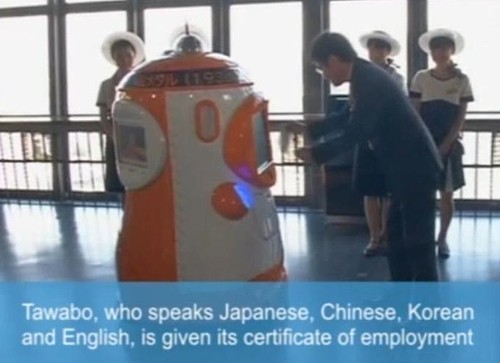
This may seem fantastical now during this transition phase of development but already relatively undeveloped robots are being used as tour guides and remote doctors. As more privatisation puts more people at the mercy of the profit motive, exposure to replacement by robot is only limited by the current capabilities of contemporary science.
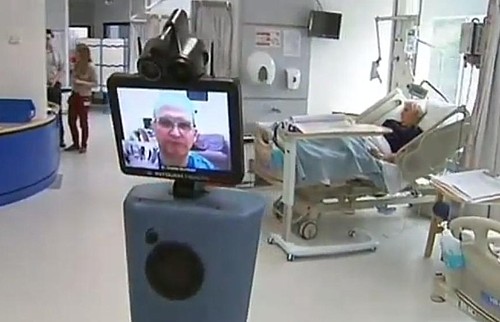
Will things be cheaper? Many cars are made by robots but are not startlingly cheap because of competition (as competitors also have to invest in the same latest technology). Will there be an ‘abundance of stuff’? The planet already provides an abundance of stuff yet the World Bankestimated 1.29 billion people were living in absolute poverty in 2008. Can the planet keep providing an ‘abundance of stuff’? The process of resource depletion of finite raw materials would only be accelerated by an increased amount of robots working in more fully-automated factories.
One could argue that trades unions and professional associations
would never let this happen yet redundancy and non-replacement of
retired workers is opening up a gap which can be filled by sophisticated
robots. Only stronger ties building on the common interest between the
unemployed and employed can possibly resist this coming workplace
crisis.
Notes
[1] Steven E. Jones, Against Technology: From the Luddites to Neo-Luddism (New York: Routledge, 2006) p.96[2] See Luddite bicentenary resource site:http://www.ludditelink.org.uk/ and Chumbawamba’s English Rebel Songs 1381–1984 ‘The Triumph of General Ludd’ https://www.youtube.com/watch?v=cuBgeGKPGZI
[3] Friedrich Engels, Condition of the Working Class in England (1845). See:
http://www.marxists.org/archive/marx/works/1845/condition-working-class/ch08.htm
[4] ‘Virtual receptionists replacing the real thing’ by John Dodge. See: http://www.smartplanet.com/blog/thinking-tech/virtual-receptionists-replacing-the-real-thing/3095
[9] http://www.imdb.com/title/tt0050307/[10] http://www.imdb.com/title/tt0063985/?ref_=fn_al_tt
[11] http://andrewmcafee.org/2013/04/mcafee-robots-work-employment-future/










